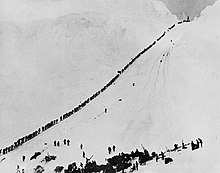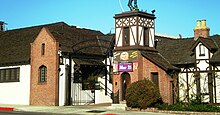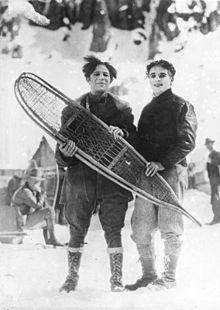Gold Rush (Chaplin)
| Movie | |
|---|---|
| German title | Gold rush |
| Original title | The gold rush |
| Country of production | United States |
| original language | English |
| Publishing year | 1925 |
| length | 96 minutes |
| Age rating | FSK 6 |
| Rod | |
| Director | Charlie Chaplin |
| script | Charlie Chaplin |
| production | Charlie Chaplin |
| camera |
Jack Wilson , Roland Totheroh |
| occupation | |
| |
Gold Rush (Original title: The Gold Rush ) is a silent movie - comedy of Charlie Chaplin from the year 1925 . The film focuses on the Klondike gold rush . Chaplin uses the knighthood of gold seekers , which is brought to the extreme in the film, as a metaphor for a world that is only oriented towards material values, in which, despite all clumsiness , he ultimately finds his personal happiness in the form of love. The strip was republished several times, so Chaplin brought it out in 1942 in a sound film version.
action
Alaska , late 19th century: a trek of adventurers headed for the wilderness to look for gold. Among them is the tramp who is looking for shelter in a hut in an icy snowstorm, but which is already inhabited by the criminal Black Larsen, wanted by the police. Then there is the coarse but good-natured adventurer Big Jim, who recently found gold. When the food runs out, Black Larsen is drawn to go in search of food. He meets two bounty hunters and kills them, then accidentally finds Big Jim's gold mine and does not come back to the hut.
The tramp then cooks one of his shoes for the other two. He eats his part of the shoe with relish in one of the most famous scenes of the film: he unwinds the shoelaces like spaghetti and gnaws off the shoe nails like chicken bones. Almost mad with hunger, Big Jim sees an oversized chicken in the tramp that he is trying to catch and slaughter. The situation eases when the tramp manages to shoot a bear.
They part ways. Big Jim goes back to his gold pot, where he finds Black Larsen, who knocks him down, but falls down a slope on the run. The tramp has meanwhile arrived in a gold rush town and falls in love with the barmaid Georgine, who is in a turbulent relationship with the cocky Jack Cameron. The tramp is taken in by a good-natured prospector who sets off on an expedition and tells him to take care of his hut while he is away. A few days later he happened to meet Georgine again, who was going on a trip with some friends. He invites her to the hut, where the women accidentally discover a photograph of Georgine that the tramp is keeping and learn that he has fallen in love with the girl. They then decide to play a prank on him and pretend to accept his invitation to a New Year's Eve dinner.
The tramp earns the money for his party with snow shovels. On New Year's Eve he set a festive table. While he is waiting for Georgine and her friends, he falls asleep. His guests have arrived in his dream and he entertains them with the "Bread Dance", another scene that has gone down in film history: he moves two buns impaled on forks to the beat of the music like the feet of a dancer. When the tramp wakes up, he can already hear the New Year's bells and is still alone. Disappointed, he goes into town to look for Georgine in the dance hall.
There he meets Big Jim, who can no longer remember the exact location of his gold discovery because of the blow Black Larsen dealt him. He only knows that he was near the hut. The tramp should now lead him there, then he wants to share with him and make them both millionaires. In fact, the tramp manages to find the hut again. The two celebrate with a lot of alcohol and go to sleep. During the night, a snow storm blows the hut halfway over an abyss. When the two prospectors wake up the next morning, they initially believe that the swaying of the floor is due to their hungover condition. They can barely save themselves on solid ground before the hut crashes into the abyss. They find the gold right nearby and return as millionaires, as Big Jim predicted.
They leave Alaska on a steamer. For a photographer, the tramp, now dressed in tailcoat and top hat, is supposed to put on his torn-off gold digger outfit once more. When taking photos, it falls on the tween deck, where the less well-heeled passengers are. There he meets Georgine, who happens to be on the steamer as well. She thinks he's a stowaway and tries to hide him. When this fails, she offers to pay him the crossing. In the meantime, however, journalists and ship officers have joined the group to clear up the misunderstanding. The tramp whispers something in the ear of a journalist, apparently intending to marry Georgine.
production
Emergence


After the great success of The Kid , Chaplin looked in vain for a new idea. Then in the fall of 1923 he was invited by Douglas Fairbanks and Mary Pickford . They showed Chaplin various stereoscopic photographs. One picture caught his eye: it showed a long procession of gold diggers climbing the Chilkoot Pass in northern Canada . Chaplin immediately got hold of literature on the gold rush . A book about the so-called Donner tragedy was very inspiring for him : a gold prospecting trek led by George Donner had been trapped in the snow in the Sierra Nevada . In this desperate situation there was cannibalism , some ate their shoes and their laces.
Filming
The test recordings began on February 8, 1924. First, Chaplin had the sets for the opening scenes built in California . But then he decided to shoot the exterior at Truckee in the Sierra Nevada mountains. A gold rush village was built there with great difficulty. The costs were enormous from the start, and Chaplin also had most of the scenes filmed at Truckee re-shot in the California studio.
As always, Chaplin worked without a script and improvised if necessary. Sometimes nothing was shot for weeks when he had to think about the progress of the story. The huge film crew - actors, cameramen, set shifters, lighting technicians, etc. - had to be ready at all times.
In May 1925, filming was completed. More than seven kilometers of film material had been exposed, only a fraction of which was used for the final version, which Chaplin himself put together in the editing room.
publication
The premiere was on June 26, 1925 in Los Angeles.
Gold Rush cost nearly a million dollars to produce . United Artists was the film distributor. The film grossed about six million dollars over the next few years.
In 1942 Chaplin added narrative texts (dialogues) and music to his film for a re-release. Among other things, the end was shortened. Chaplin dedicated this sound film version to Alexander Woollcott .
backgrounds

- Since Chaplin was a perfectionist (he was the first to shoot retakes of all the scenes, which he then assembled on the editing table himself), the scene with the licorice shoe was repeated until Swain began to complain about constipation problems. The tortured facial expression with which Swain accompanies the preparation, serving and consumption of the licorice shoe in this scene is actually not played.
- The originally intended actress of the Georgine, the only 15-year-old Lita Gray , became pregnant during the filming days of Chaplin, after which the two married each other and had to stand in for the film role Georgia Hale. Lita Gray had to be content with an extra role, while her husband Chaplin was having an affair with leading actress Hale at the time of filming, as Hale later wrote in her autobiography. After filming, Chaplin's marriage to Lita Gray was about to end.
- In the New Year celebration scene in the saloon, there is a spot where two old, bearded, white and long haired men are performing a short folk dance. Chaplin later reported that these were two real, old gold diggers who had come by the filming and spontaneously performed this dance, which was then just as spontaneously recorded and incorporated into the film. One of the two men was named Daddy Taylor and was reportedly born in 1828, making him nearly 100 years old.
- The “roll dance” that Chaplin dreams of showing his female guests on New Year's Eve is almost legendary. He sticks a fork into two rolls and dances the legs of a fictional dancer at the table. Johnny Depp reenacted the dance in his film Benny and Joon . This was the most difficult scene in the film for him. Charly's film colleague Roscoe Arbuckle , in The Rough House (1917), had skewered buns dance around on the tablecloth, but Chaplin now parodied the running gag - the waddling walk - of his own tramp role.
- The rights to this film are now owned by the Roy Export Company Establishment .
- After the sale of his Charlie Chaplin Studios in 1954, Chaplin gave orders to confiscate and destroy all copies of the 1925 version. He took action against film distributors in Germany and Switzerland.
- Although Sid Grauman was mainly active as an entrepreneur, he stood in front of the camera three times in his life as an actor in smaller cameo appearances, including in Gold Rush at Chaplin's side. Grauman's father, David Grauman, followed the gold rush of the Klondike gold rush with many other adventurous men in 1898, tempted to get rich, so he moved his family to Dawson City, Canada. Sid spent his childhood and youth there. However, the family did not get rich from gold.
Reviews
Chaplin himself considered gold rush to be the best of his films, "[...] I want to be remembered with this film." ( Chaplin )
“Reality and dream, action and poetry in a silent film that Chaplin himself considered to be his best and that established his world fame. Unforgettable the scene in which the starving Charlie gleefully devours his shoe. "
“A tragicomic grotesque from the curse of the gold rush, in which the artistic vitality of Chaplin's comedy comes to the fore. Recommended as a masterpiece of the silent film era. "
Awards
- Something unique happened at the Berlin film premiere: the wildly clapping audience forced a da capo of the bread roll dance during the performance.
- 1943 - two Oscar nominations for the sound and the soundtrack of the reworked sound version
- 1991 - Inclusion in the US National Film Registry of the Library of Congress
- Gold Rush is on the American Film Institute's list of the 100 Best American Movies of All Time
- In 2003 included in the film canon of the Federal Agency for Civic Education .
Individual evidence
- ↑ Jennifer E. Michaels: "Chaplin and Brecht: The Gold Rush and The Rise and Fall of the City of Mahagonny", in: Literature / Film Quarterly, 1980
- ↑ Goldrausch at Wissen.de ( Memento of the original from April 27, 2010 in the Internet Archive ) Info: The archive link was inserted automatically and has not yet been checked. Please check the original and archive link according to the instructions and then remove this notice.
- ↑ a b Gold Rush ( Memento from April 13, 2014 in the Internet Archive )
- ↑ dieterwunderlich.de. Charlie Chaplin: Gold Rush
- ↑ see below a. Film leader of the sound film version from 1942
- ↑ a b David Robinson: Chaplin. His life. His art. 2nd Edition. Diogenes Publishing House. Zurich 2002. ISBN 3-257-22571-7
- ↑ IMDb Trivia
- ^ "Daddy Taylor" at the Internet Movie Database
- ^ Depp Impact Benny & Joon
- ^ Controversy over "Gold Rush" - Charlie Chaplin obtains court ruling, Fränkische Nachrichten, Tauberbischofsheim edition of June 15, 1963
- ^ Judgment of the I. Civil Department of November 3, 1970 by Monopol-Films AG against Chaplin and The Roy Export Company Establishment, accessed on March 4, 2016
- ↑ https://www.imdb.com/name/nm0336138/
- ↑ Michael Töteberg (Ed.), Metzler Filmlexikon., JB Metzler Verlag, Stuttgart / Weimar 1995
- ↑ List of the best 100 American films
Web links
- Gold Rush in theInternet Movie Database(English)
- The Gold Rush in the catalog of the American Film Institute (English)

